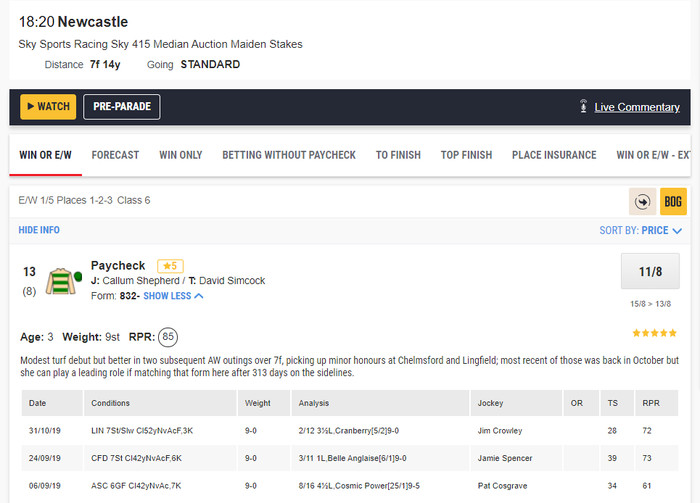 If you want to bet on horse racing there are various options available when it comes to deciding what to bet on. You can follow our betting tips, check out the tipsters in the big newspapers, choose a horse whose name you like, pick entirely at random or, of course, you could consider and assess the form.
If you want to bet on horse racing there are various options available when it comes to deciding what to bet on. You can follow our betting tips, check out the tipsters in the big newspapers, choose a horse whose name you like, pick entirely at random or, of course, you could consider and assess the form.
In truth we would recommend using a combination of your own thoughts on the form, course and conditions alongside tips from others but to do that you need to know how to study form and how to read a racecard and that’s just what we’ll explain here.
The Racecard

A racecard can, and indeed does, look like a mass of confusing information to those unaccustomed to reading them but in fact understanding them is actually quite straightforward. Once you know what certain abbreviations mean, what information is detailed where and what are the most important factors to consider, reading a card and assessing the form is a doddle.
At the top of the card are the details of the race itself and these are the first factors to consider. You’ll see the name of the track and (AW) if it’s an all-weather surface, the time it is set to run, the name of the race and other information including race distance, race class and type, the number of runners, the going and race qualifications (such as a minimum age).
Looking at the card itself (based on the Ladbrokes card, although most of the features are present on all racecards) you have the following information:
- Number – the big number on the far left is the number of the horse and this has no bearing on who will win, unless you want to bet on a “lucky” number.
- Draw – the small number in brackets indicates the draw, the starting position the horse will take.
- Past Results – the small numbers underneath the horse’s number indicate the past results, with the most recent on the right, figures left of a hyphen being from last season and left of a slash the season before that. More info on this is given below.
- Silks – a pictorial representation of the silks, clothes, the jockey will wear, including the helmet
- Name – the horse’s name
- Past Performance – in small boxes next to the name are letters such as C or D. Again, we will explain more about these below
- Tips – there may be a small number indicating how many of a selected bunch of news outlets have selected this horse as their pick
- Heading – beneath the tips number is the RPR rating, although note this excludes jockey’s allowance
- Trainer – under the name of the horse come two names and the trainer is on the right, there may be a number next to this the percentage of their horses who have run to form
- Jockey – also shown is the name of the jockey riding the horse, if there is a small number next to their name, that is the weight they claim, meaning their horse carries less weight
- Age – next come three sets of numbers, the first being the age of the horse
- Weight – the weight, shown as 9st, is the weight carried by each horse, 9 meaning nine stone and zero pounds
- Official Rating – you will often also see the Official Rating of the horse which is used to create the handicap and can only be granted once the horse has won a race or raced at least three times with at least one top six finish
Reading Form

The most basic information is provided on the racecard as detailed above but further information is also available and using all of this we can begin to assess a horse’s merits and its chances of success in a given race. Let’s look first of all at some of the information above and how it applies to predicting the outcome of the race, before considering the other important factors to consider.
- Draw – especially in shorter races the draw can have a significant impact on who will win a race, with history and stats from previous races indicating that horses drawn higher, lower, or even in the middle, have had an advantage
- Past results – it’s easy to read too much into these as, of course, it matters not just that a horse won before but also how it won and what sort of race it was, both in distance and standard, as well as a good number of other variables. Note that finishing positions 1-9 are listed by number, with a 0 for a finish of 10th or worse and that P means pulled up, F means fell, R is a refusal, B is brought down, S is slipped up and finally U means the rider was unseated.
- Past Performance – here you may see a range of letters, with C meaning the horse has won at the course before, D meaning it has won over this distance, CD meaning course and distance (in the same race, e.g. CD, as opposed to C and separately D), whilst BF means it was a beaten favourite – not a good sign.
- Trainer – knowing the trainer in isolation isn’t necessarily of great benefit but in conjunction with trainer stats it can be useful. Just as a team, player or horse can be in good form, so can a trainer, whilst they may also have a good record at a given track.
- Jockey – the same applies to a jockey as to a trainer, with confidence being a big factor in a jockey’s performance.
- Age – some races and courses may favour younger or older horses and this can be assessed by looking at the ages of previous winners of a given race.
- Weight – the more weight a horse has to carry the slower it will go, in theory, and this is how the handicapping system works, with factors like the going and type and distance of the race also affecting how important the extra weight may or may not be.
Past Races and Racing Form

One of the most important factors in deciding whether a horse will do well in a race is how it performed in previous races. Usually recent races would have most relevance, whilst it’s also crucial to consider things like injury and time away from the track.
Whilst the racecard will tell you if a horse won its last race or whether it has won at this track in the past, only by looking in more detail at its performances – and indeed those of all the horses in the race – can you get a true picture of how an upcoming contest might pan out.
One of the most important factors to consider is the standard of the previous races. A horse may have won its last three races but if it’s making a huge step up in class that would explain its long odds. Distance is another key factor to look at as a horse may have lost previously due to tiring in the closing stages but if it is now racing over a shorter distance it could be one to watch – at long odds too if the market hasn’t realised this. Similarly the going – the state of the track – can be crucial, with some horses loving a muddy track whilst others needing hard, fast ground to be at their best.
The best betting sites have cards that provide all of this information and more, with some even allowing you to watch past races and providing a brief synopsis of a given horse’s performance. If you put the time and effort in you’ll get your rewards and many keen racing punters really enjoy the challenge of picking through all the information to try and uncover that long odds winner that everyone else has overlooked.
